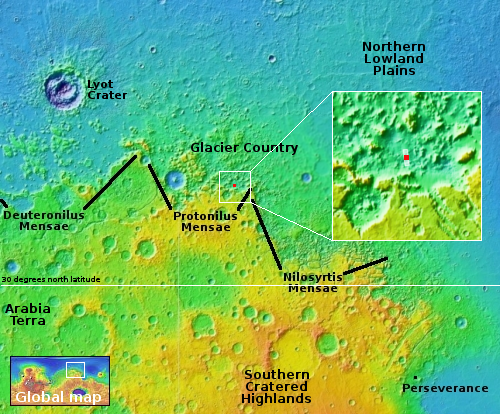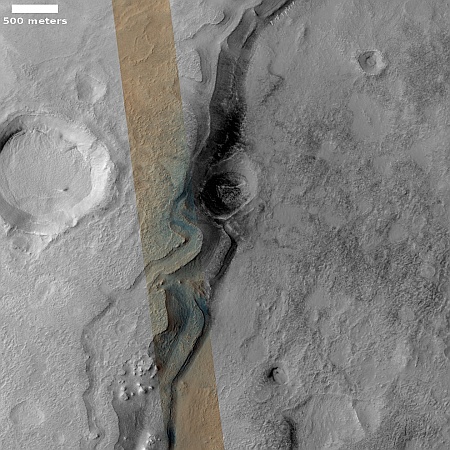Glacial layers in Mars’ glacier country
Cool image time! The picture to the right, cropped, reduced, and sharpened to post here, was taken on August 20, 2023 by the high resolution camera on Mars Reconnaissance Orbiter (MRO). It features a 250-foot-high north-south cliff that appears to have numerous horizontal layers within it.
Moreover, both on the plateau above the cliff as well as the floor below it, the entire surface seems to resemble a thick snow/ice field, made even more evident by the distortion of many craters and the apparent glacial material inside each crater.
The layers suggest that this ice was laid down in a series of cycles. During cold periods snow fell and accumulated as ice over time. When things became warmer some of that ice sublimated away, but not all. With the next cold cycle a new layer was put down.
The many layers suggest many climate cycles on Mars, none of which were caused by SUVs or coal-firing electrical power stations.

The red dot on the overview map to the right marks this location, within the 2,000-mile-long northern mid-latitude strip I dub glacier country, as every surface image shows evidence of near-surface ice and glacial features.
This particular picture is inside an open low area between many mesas, and it appear that the entire ground in this valley is covered by glaciers that flowed down from those mesas. To the north of this picture (and visible partly in the full original image) is a dense cluster of craters, likely caused either by a single impact of an object that broke up as it bored through the Martian atmosphere, or by a spray of ejecta from a larger impact nearby.
For future colonists the evidence continues to mount that finding water on Mars will not be difficult.
On Christmas Eve 1968 three Americans became the first humans to visit another world. What they did to celebrate was unexpected and profound, and will be remembered throughout all human history. Genesis: the Story of Apollo 8, Robert Zimmerman's classic history of humanity's first journey to another world, tells that story, and it is now available as both an ebook and an audiobook, both with a foreword by Valerie Anders and a new introduction by Robert Zimmerman.
The print edition can be purchased at Amazon or from any other book seller. If you want an autographed copy the price is $60 for the hardback and $45 for the paperback, plus $8 shipping for each. Go here for purchasing details. The ebook is available everywhere for $5.99 (before discount) at amazon, or direct from my ebook publisher, ebookit. If you buy it from ebookit you don't support the big tech companies and the author gets a bigger cut much sooner.
The audiobook is also available at all these vendors, and is also free with a 30-day trial membership to Audible.
"Not simply about one mission, [Genesis] is also the history of America's quest for the moon... Zimmerman has done a masterful job of tying disparate events together into a solid account of one of America's greatest human triumphs."--San Antonio Express-News
Cool image time! The picture to the right, cropped, reduced, and sharpened to post here, was taken on August 20, 2023 by the high resolution camera on Mars Reconnaissance Orbiter (MRO). It features a 250-foot-high north-south cliff that appears to have numerous horizontal layers within it.
Moreover, both on the plateau above the cliff as well as the floor below it, the entire surface seems to resemble a thick snow/ice field, made even more evident by the distortion of many craters and the apparent glacial material inside each crater.
The layers suggest that this ice was laid down in a series of cycles. During cold periods snow fell and accumulated as ice over time. When things became warmer some of that ice sublimated away, but not all. With the next cold cycle a new layer was put down.
The many layers suggest many climate cycles on Mars, none of which were caused by SUVs or coal-firing electrical power stations.

The red dot on the overview map to the right marks this location, within the 2,000-mile-long northern mid-latitude strip I dub glacier country, as every surface image shows evidence of near-surface ice and glacial features.
This particular picture is inside an open low area between many mesas, and it appear that the entire ground in this valley is covered by glaciers that flowed down from those mesas. To the north of this picture (and visible partly in the full original image) is a dense cluster of craters, likely caused either by a single impact of an object that broke up as it bored through the Martian atmosphere, or by a spray of ejecta from a larger impact nearby.
For future colonists the evidence continues to mount that finding water on Mars will not be difficult.
On Christmas Eve 1968 three Americans became the first humans to visit another world. What they did to celebrate was unexpected and profound, and will be remembered throughout all human history. Genesis: the Story of Apollo 8, Robert Zimmerman's classic history of humanity's first journey to another world, tells that story, and it is now available as both an ebook and an audiobook, both with a foreword by Valerie Anders and a new introduction by Robert Zimmerman.
The print edition can be purchased at Amazon or from any other book seller. If you want an autographed copy the price is $60 for the hardback and $45 for the paperback, plus $8 shipping for each. Go here for purchasing details. The ebook is available everywhere for $5.99 (before discount) at amazon, or direct from my ebook publisher, ebookit. If you buy it from ebookit you don't support the big tech companies and the author gets a bigger cut much sooner.
The audiobook is also available at all these vendors, and is also free with a 30-day trial membership to Audible.
"Not simply about one mission, [Genesis] is also the history of America's quest for the moon... Zimmerman has done a masterful job of tying disparate events together into a solid account of one of America's greatest human triumphs."--San Antonio Express-News



problem is all the perchlorates
if colonists ever want to step outside a cave or bubble on a regular basis, we’ll need to warm the planet enough for liquid water to wash out the perchlorates
fortunately the red planet is small, and Venusian sunshields can divert enough Sun power to warm substantial portions for open-air Martian colonies where you’d only need oxygen